Yellampalli S. (ed.) Carbon Nanotubes - Synthesis, Characterization, Applications
Подождите немного. Документ загружается.

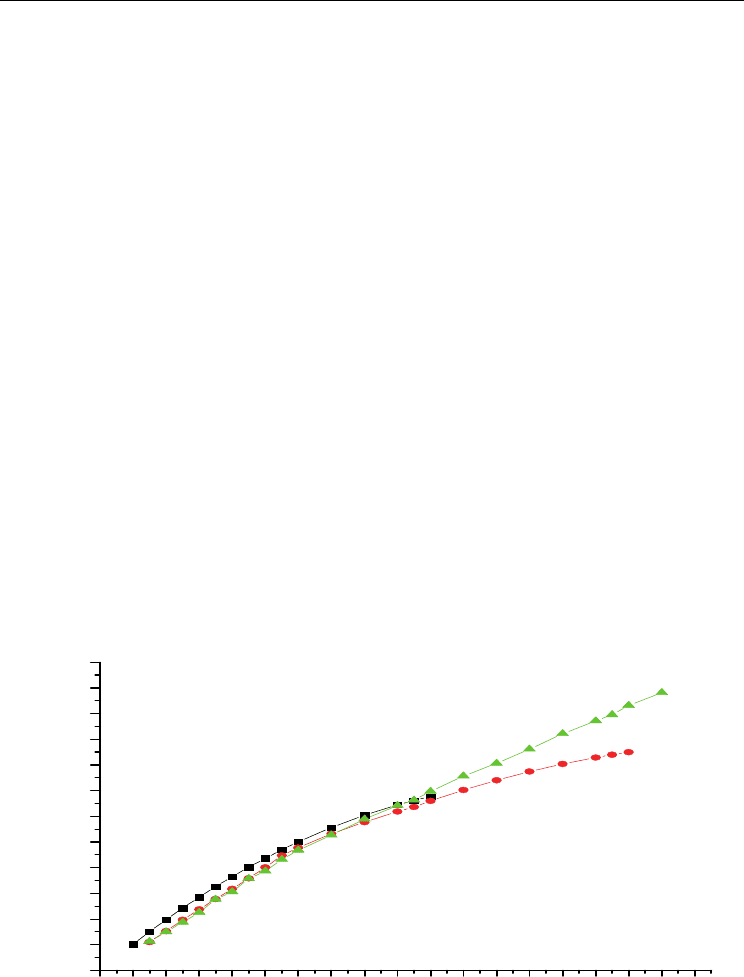
Molecular Dynamics Simulation Study on the Mechanical
Properties and Fracture Behavior of Single-Wall Carbon Nanotubes
297
thickness and l the length of the tube. We have taken δr as 0.34 nm, which has been the
standard value, used by most of the authors. To calculate stress from the energy-strain curve
we have used a linear relationship for the elastic region and appropriate non-linear
equations for the segments of high strain deformation regions. Young’s modulus is found
from the slope of the linear portion of the stress-strain curve. By changing the (z, r, θ) values,
defects are created at different positions of the same tube. θ is changed by 90
0
from its first
value to form two oppositely directed defects. To produced two diagonal defects θ is
changed by 45
0
and z is adjusted to the desired value.
5.2 Characteristics of defect free tubes
With Brenner’s 2nd generation REBO potential an armchair SWCNT shows remarkable
ductility of 32% and tensile strength of 196.3 GPa [Fig 1]. A chiral tube breaks at 30% strain
while its failure stress is calculated to be 149.88 GPa. The ductility and failure stress of a
zigzag tube, in contrary, are much less and that are 18% and 115.4 GPa respectively. Linear
elastic region extends upto 7% strain, beyond which the nature of the curve changes to non-
linearity. Young’s modulus is found for the pristine tube as 1.06 TPa for a zigzag tube, 0.891
for a chiral tube and 0.814 for an armchair tube. Our calculation matches with the
experimental values of failure stress by Demczyk (Demczyk et al., 2002) which is 150±45
GPa. Young’s modulus value is also close to the experimental value of 1.28 TPa by Wong et
al. (Wong, 1997) and 1.25 TPa by Krishan et al. (Krishnan et al., 1998). Maximum strain can
be compared with the results of quantum mechanical calculations (Ozaki et al., 2000; Troya
et al., 2003) though 10-13% maximum strain and failure stress between 13-52 GPa were
observed by Yu et al. (Yu et al., 2000c) experimentally. Fracture of a zigzag SWNT [Fig 2(a)]
is found to be brittle in our calculation. As shown in Fig 2(b) and 2(c), failure patterns are
not so sharp for a chiral and an armchair tube.
-0 .0 20 .0 00 .0 20 .0 40 .0 60 .0 80 .1 00 .1 20 .1 40 .1 60 .1 80 .2 00 .2 20 .2 40 .2 60 .2 80 .3 00 .3 20 .3 4
-2 0
0
20
40
60
80
100
120
140
160
180
200
220
A rm c h a ir (5 , 5 )
C h ira l (5 ,3 )
Zigzag (10, 0)
STRESS IN GPa
STRAIN
Fig. 1. Stress-Strain curves for defect free SWCNTs
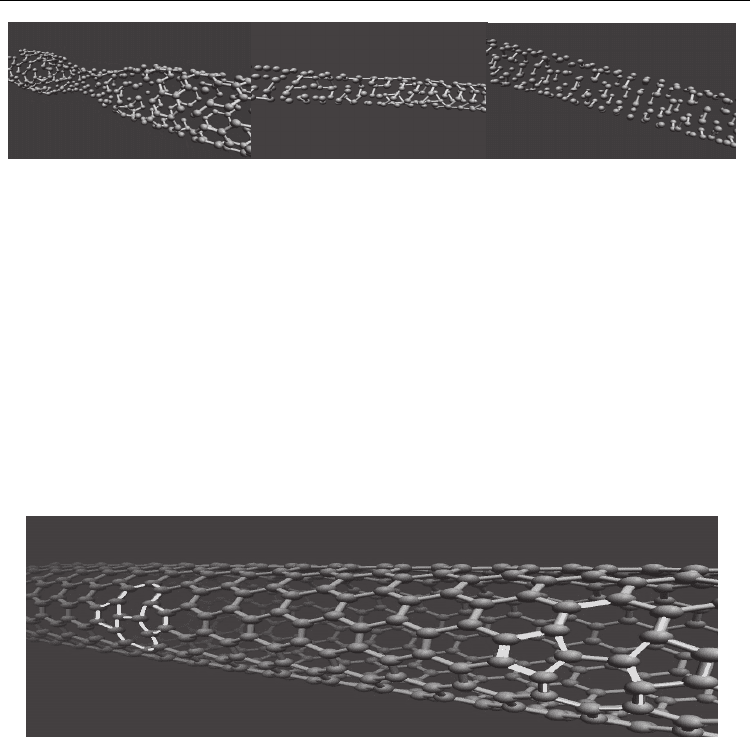
Carbon Nanotubes - Synthesis, Characterization, Applications
298
(a) (b) (c)
Fig. 2. Fracture patterns of a defect free (a) zigzag (10, 0) (b) Chiral (5, 3) and (c) Armchair (5,
5) SWCNTs
5.3 Modeling of defects
A 5/7/7/5 defect is realised theoretically by rotation of a C-C bond by 90
0
and thus
converting two pair of hexagons to two pentagons and two heptagons. Single defect is
created in any desired place by adjusting (z, r, θ) values. For more than one defect z values
are changed to produce separated defects and orientation between two defects or oppositely
situated defects are produced by changing θ. Symmetric defects mean that they are situated
symmetrically on both sides of z=0 position. Same θ for a number of defects produces some
defects on the same line. Where θ varies by 180
0
, oppositely situated defects are produced.
Thus, for four different combinations of z, r and θ as (-4.26,3.91,90), (-12.78,3.91,90),
(4.26,3.91,-90), (12.78,3.91,-90), four symmetrical but oppositely situated defects are
produced. Fig 3 shows a (8, 8) SWCNT with two defects at different positions.
Fig. 3. Two SW-defects shown in a (8, 8) SWCNT
5.4 Variation of tube properties with defects
5.4.1 Effect of a single defect
With only one defect an SWCNT shows a scattering of data for all mechanical characteristics
for different position of its formation. The variation is most pronounced for an armchair
tube. Fig 4 shows the stress-strain curves for a (5, 5) SWCNT with a single defect at different
positions. The curves for z=-15 and z=-20 show completely different nature. A defect at the
edge which is opposite to the loading side and is oriented parallel to the axis of the tube is
shown by the pink line in Fig 4. The different nature of the curve proves such defect does
not affect the mechanical behavior in a considerable amount. The defect energy (E
d
) for a
defect near that edge (z=15.98 or 19.17) is greater than that of other defects for small strains
but lower for large strains. While straining the tube with such defects at the far end, excess
strain due to the formation of the defect is released irrespective of its orientation. However,
E
d
is always lower for a pristine tube compared to others at small strains but higher for large
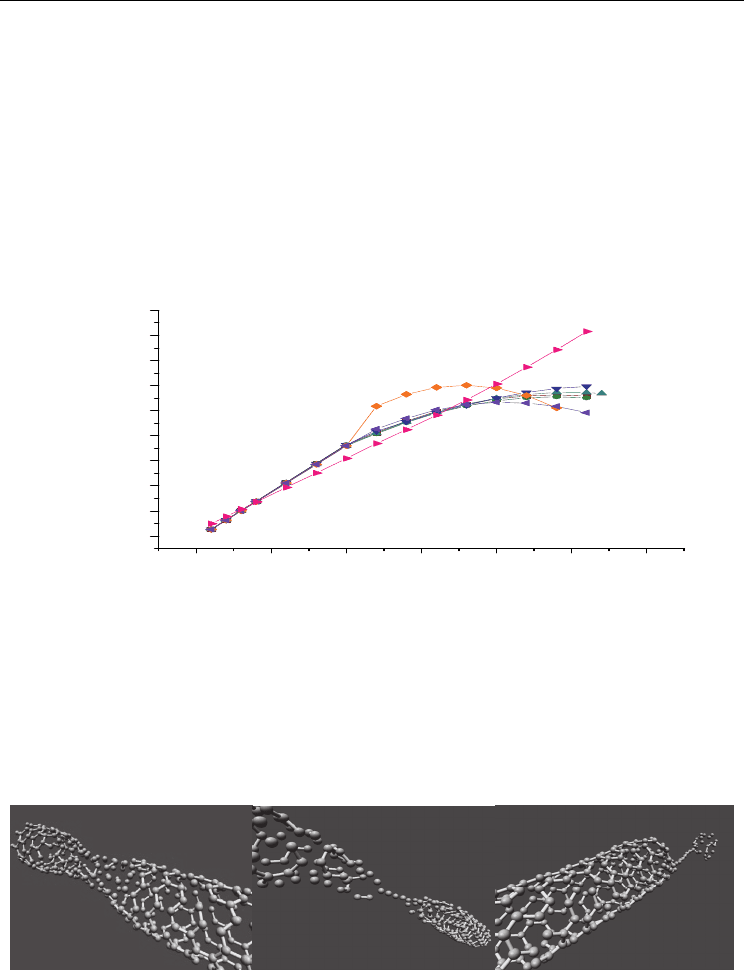
Molecular Dynamics Simulation Study on the Mechanical
Properties and Fracture Behavior of Single-Wall Carbon Nanotubes
299
strains. Tabulated results for the variation of the mechanical properties of the three types of
tubes are given in Table 2, 3 and 4. Mechanical responses of the chiral and zigzag tubes
show some variation. Maximum reduction of Young’s modulus is observed with a single
defect for a (5,5) tube with a defect situated near the edge and the reduction is 29%.
However, the maximum reductions of Y values are 24% and 16% for a (10,0) and a (5,3) tube
respectively. Ductility of a zigzag tube is not influenced by any defect present in its
structure. But whatever is the position of the defect, breaking starts from the defect site. Fig
5 reveals that breaking of a chiral or armchair tube is brittle in nature. Necking is observed
in case of a zigzag tube For a pristine tube we have observed that the applied force results
in many SW rotations after 10% strain as reported by Zhang et al. (Zhang et al., 1998). Stress-
strain curves [Fig 4] show the variation of the mechanical behavior of the tube mainly in the
non-linear portion after inclusion of a single defect at different places.
0.00 0.05 0.10 0.15 0.20 0.25 0.30
0
20
40
60
80
100
120
140
160
180
z=-20
z=20
z=-15
z=15
z=-5
z=5
z=0
STRESS IN GPa
STRAIN
Fig. 4. Stress-strain curves for a (5, 5) SWCNT with a single defect at different positions
For a chiral tube tensile strength reduces by 34% and strain by 23% [Table 3] and the
reductions are 45.6% and 25% respectively for an armchair tube [Table 4]. E
d
for defects
situated near the edge in case of the chiral and zigzag tubes are higher than that situated in
the mid position like a zigzag tube. As the bond between two pentagons is very week, the
tube with such SW defect where pentagons oriented along the loading direction breaks
easily. Where pentagons are inclined with the axis, the tube offers more resistance before
breaking.
(a) (b) (c)
Fig. 5. Breaking patterns of a (a) (10,0) SWNT with 1 defect at (z, r, θ) position (15.98, 3.87, 9)
(b) Chiral tube with a defect at (0.61, 2.65, 92) (c) armchair tube with a defect at (15.37,
3.37,90)
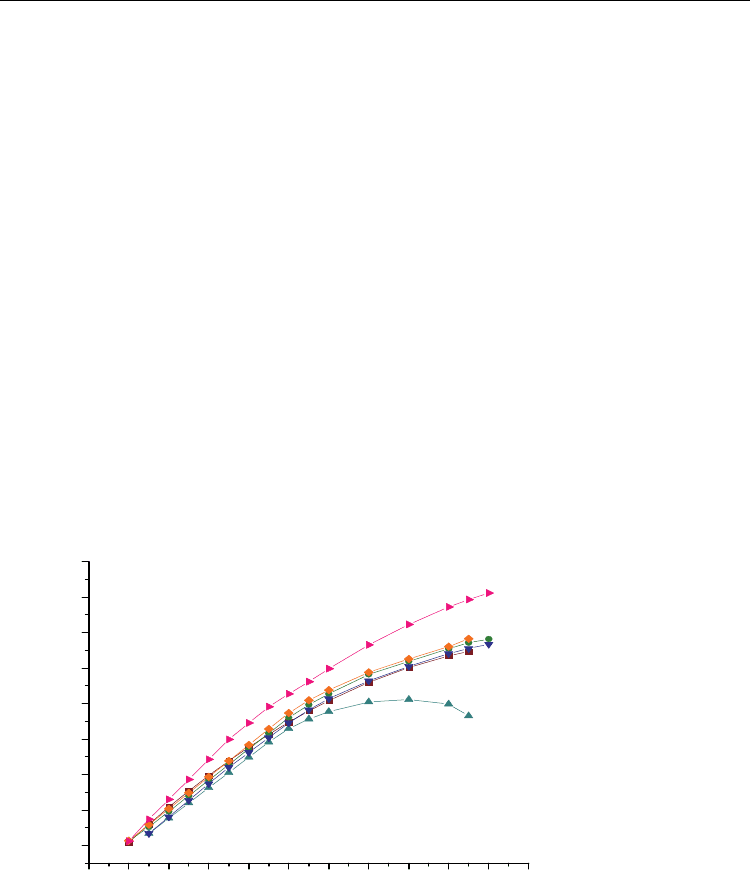
Carbon Nanotubes - Synthesis, Characterization, Applications
300
5.4.2 Effect of a couple of defects
More variation of result is obtained after the inclusion of 2 defects [Fig 6]. But tensile
strength and Y value are higher than the result of inclusion of one defect except for two
diagonally situated defects and when the defects are situated on the same line separated by
a distance. Thus for the combinations (-1.06, 3.87, -9), (1.06, 3.87, 27) and (-3.19, 3.87, 27),
(3.19, 3.87, 27) the reduction of tensile strength is 41.9% and 39.4% for the (10, 0) tube. When
the two defects are not on the same line, rather situated opposite to each other with z
position 0 and 8.52, the defects can not reduce the strength. In each case the nature of defect-
defect interference is different. The stress-strain curves are shown in Fig 6 which
distinguishes between different defect separation and orientation. A defect can be
represented by an edge dislocation which produces gliding motion .The glide is
accompanied with attachment or breaking of bonds when atoms move together and the
changes are observed for the atoms in the line of glide motion. The atoms and bonds below
and above the defect change. So attraction or repulsion between defects is possible
according to their distance of separation and orientation (Samsonidze et al., 2002). If
attraction occurs, the moving dislocations pile up such that the energy of the system slowly
decreases due to the application of the external force. On the other hand any external force
should bring the system to the minimum energy state easily if repulsive interaction acts
between the defects. So repulsive interference occur for the above two combinations and for
the defects at (0, 3.91, 90) and (8.52, 3.91, -90) attraction takes place. Here, the two glide
motion moves opposite to each other. The orientation angle i.e. the angle between the lines
joining the two pentagons of the two defects takes a major part in defect- defect correlation.
-0.02 0.00 0.02 0.04 0.06 0.08 0.10 0.12 0.14 0.16 0.18 0.20
0
20
40
60
80
100
120
140
160
Z=0 (oppositely situated)
Z=0,8 (oppositely situated)
oppositely situated at Z=0
diagonal defects
overlapping defects
seperated( same line)
STRESS IN GPa
STRAIN
Fig. 6. Stress-strain curves for a (10,0) SWCNT with 2 defects at different positions
For a chiral tube, two diagonal defects and two oppositely situated defects at the mid
position reduce its strength by considerable amounts. The striking fact is that, the two
overlapping defects situated side by side have no such remarkable influence on the strength.
The stress-strain curves of a chiral and armchair SWCNT with 2 defects at different
positions are depicted in Fig 7 and Fig 8.
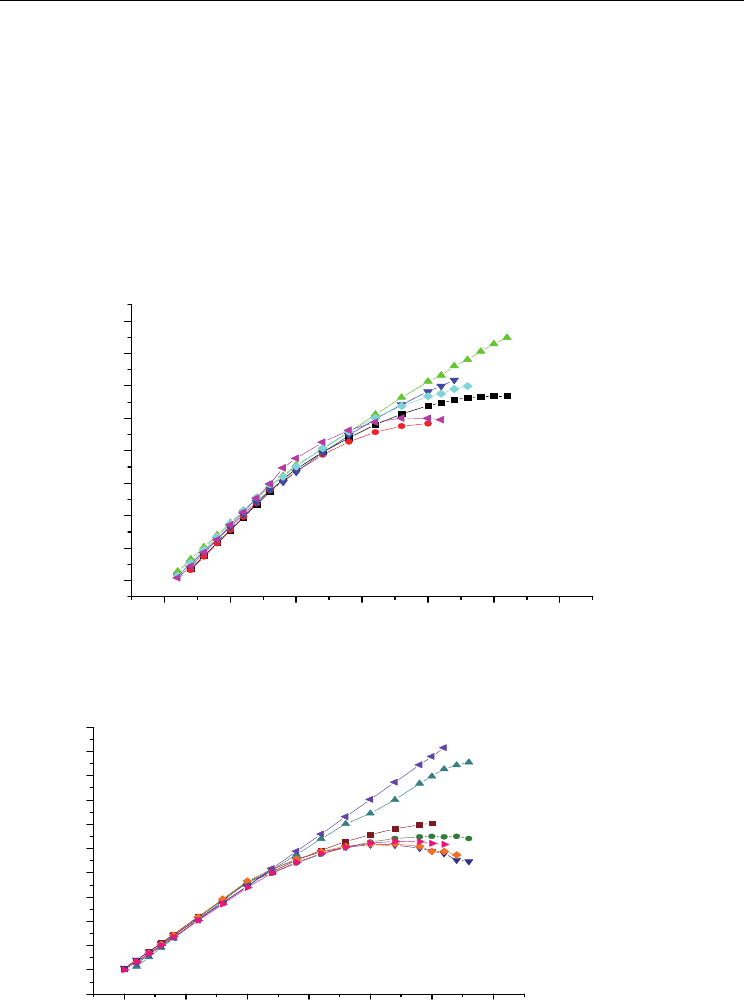
Molecular Dynamics Simulation Study on the Mechanical
Properties and Fracture Behavior of Single-Wall Carbon Nanotubes
301
Remarkable differences are observed for an armchair tube. Diagonal defects no longer
change the stress-strain curve [Fig 7] compared to the defect free tube. The armchair
symmetry helps attractive correlation between two diagonal defects while evidence of
repulsive correlation is clear in case of the chiral tube. Repulsive correlation is much weaker
for a zigzag tube in case of diagonal defects.
Breaking of a (10, 0) tube with 2 defects is accompanied with deformation of the tube in
different places as shown in Fig 9(a). Other two tubes sometimes get twisted before fracture,
especially for diagonal defects [Fig 9(c)]. It is surprising to note that breaking of a chiral tube
[Fig 9(b)] with two defects at (4.56, 2.65, 59) and (-4.72, 2.70, 53) does not initiates from any
defect site. Ruther, the tube breaks at a position near the edge of the tube. The interaction of
the chiral symmetry with the orientations of the defects as well as the angle between the
pentagons of the defects serves a crucial role in the fracture of an SWCNT.
0.00 0.05 0.10 0.15 0.20 0.25 0.30
0
20
40
60
80
100
120
140
160
Diagonal defects
z=5 & -5 (opposite side)
z=5, -5 (on the same line)
overlapping defects
z=0 (oppositely situated)
large seperation
STRESS IN GPa
STRAIN
Fig. 7. Stress-strain curves of a (5, 3) SWNT with 2 defects at different positions
0.00 0.05 0.10 0.15 0.20 0.25 0.30
-20
0
20
40
60
80
100
120
140
160
180
200
overlapping defects
diagonal defects
z=15, -15(oppositely situated)
z=15, -15 (same line)
z=5, -5 (oppositely situated)
z=5, -5 (same line)
z=0 (oppositely situated)
STRESS IN GPa
STRAIN
Fig. 8. Stress-strain curves of a (5, 5) SWNT with 2 defects at different positions
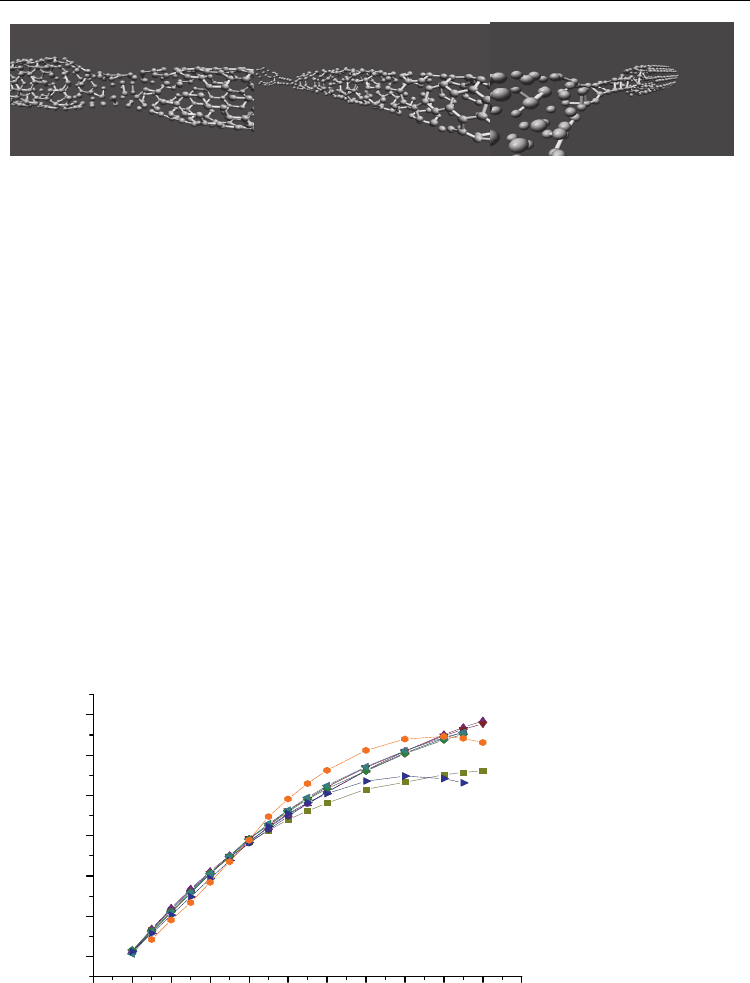
Carbon Nanotubes - Synthesis, Characterization, Applications
302
(a) (b) (c)
Fig. 9. Breaking of a (a) (10,0) SWCNT with two defects at (-1.06,3.87,-9) and (1.06,3.87,27) (b)
(5,3) SWCNT with two defects at (4.56, 2.65, 59) and (-4.72, 2.70, 53) (c) (5, 5) SWCNT with
two defects at (-0.61,3.37,90) and (0.61, 3.37,126)
5.4.3 Influence of three defects
Different combinations of three defects are taken to study the effect of odd number of
defects. An aggregation of three diagonal defects in a zigzag tube reduces the strength of the
tube to 89.58 GPa[Fig 10]. Reduction of strength is also remarkable when the defects are
close and almost on the same line (orientation of one defect differs only by 9
0
). Like two
defects on the same line, three such defects exactly on the same line have no such
pronounced effect on the tensile strength of the tube. The middle defect here is influenced
complicatedly by the other two defects. In each case different results are obtained. For the
defects that are oriented by some angle with respect to each other, curvature plays a
significant role in decreasing the strength. For defects on the same line, mainly the
separation between the defects is important. In our study maximum strain is less hampered
by the inclusion of defects for a zigzag tube.
It is revealed from our study that accumulation of a number of defects has no extra influence
on the mechanical response of a zigzag SWCNT. E
d
increases with the increase of number of
defect. But ultimately interference between defects leads to adjustment of equilibrium
energy leaving some changes in stiffness and maximum tensile capacity but ultimate strain
reduces only from 18% to 17% in some cases and sometimes it is fixed to 18%. The defects
-0.02 0.00 0.02 0.04 0.06 0.08 0.10 0.12 0.14 0.16 0.18 0.20
0
20
40
60
80
100
120
well seperated (same line & asymmetrical)
diagonal defects
overlapping defects
well seperated (asymmetrical)
oppositely situated( asymmetrical)
same line (asymmetrical)
on the same line(symmetrical)
STRESS IN GPa
STRAIN
Fig. 10. Stress-strain curves for a (10, 0) SWCNT with 3 defects at different positions
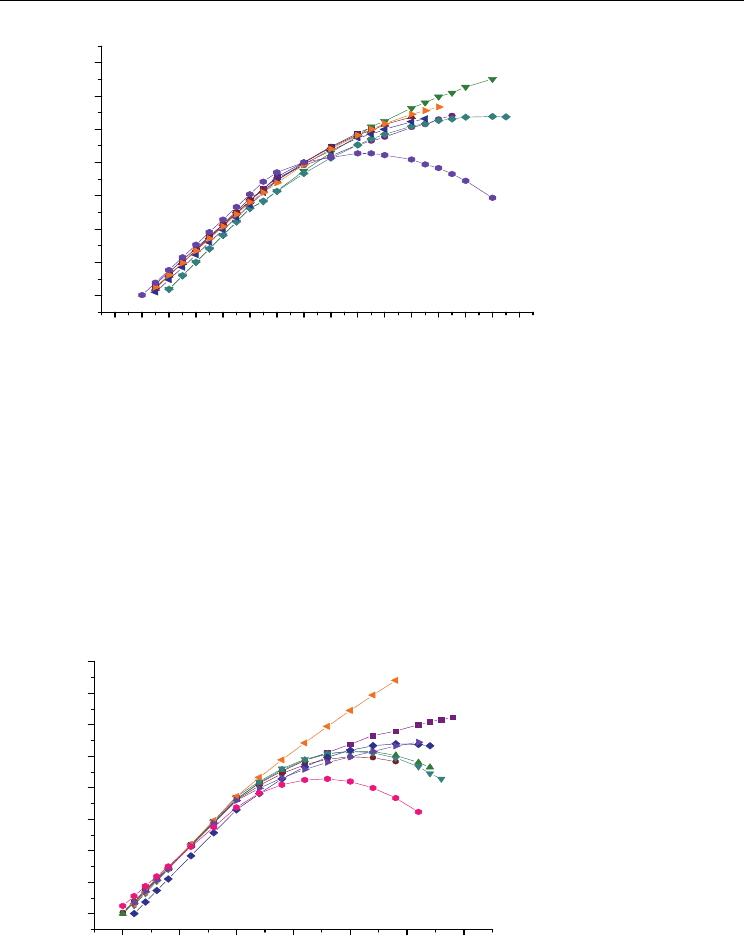
Molecular Dynamics Simulation Study on the Mechanical
Properties and Fracture Behavior of Single-Wall Carbon Nanotubes
303
-0 .020.0 0 0.02 0.0 4 0.06 0.08 0.10 0.12 0.1 4 0.16 0.1 8 0.20 0.2 2 0.24 0.26 0.28
0
20
40
60
80
100
120
140
near edge (sam e line)
same orientation
different orientations
diagonal
far apart (different orientations)
far apart(same line)
overlapping
near edge( oppositely situated)
STRESS IN GPa
STRAIN
Fig. 11. Stress-strain curves for a (5, 3) SWNT with 3 defects at different positions
created on equal distances and symmetrically on either side of the Z=0 position interact
among themselves in such a manner that the stiffness increases than the value when the
defects are asymmetric but on the same line. The observation seems to resemble with the
observations of Tunvir et al. (Tunvir et al., 2008). The result of inclusion of 3 defects for a (5,
3) and (5, 5) tubes are shown in Fig 11 and 12 below. Three overlapping defects in case of a
(5, 5) SWCNT change the pattern of the stress-strain curve [Fig 12] significantly. Failure
stress is dropped to 85.79 GPa from 196.3 GPa and maximum strain from 32% to 26% in this
case. But maximum strain is reduced mostly for 3 oppositely situated asymmetrical defects
[Table 4]. In contrary, maximum stress increased to 148.2 GPa.
0.00 0.05 0.10 0.15 0.20 0.25 0.30
0
20
40
60
80
100
120
140
160
Overlapping defects
Diagonal defects
Asym metrical & oppositely oriented
Asymmetrical (same line)
oppositely oriented
well seperated, symm etrical,
Same line, w ell seperated (sym metrical)
Same line (symmetrical)
STRESS IN GPa
STRAIN
Fig. 12. Stress-strain curves for a (5, 5) SWNT with 3 defects at different positions
Breaking of a tube with three symmetrical defects on the same line often originates from the
middle defect. But sometimes, for example for 3 overlapping defects in a zigzag tube
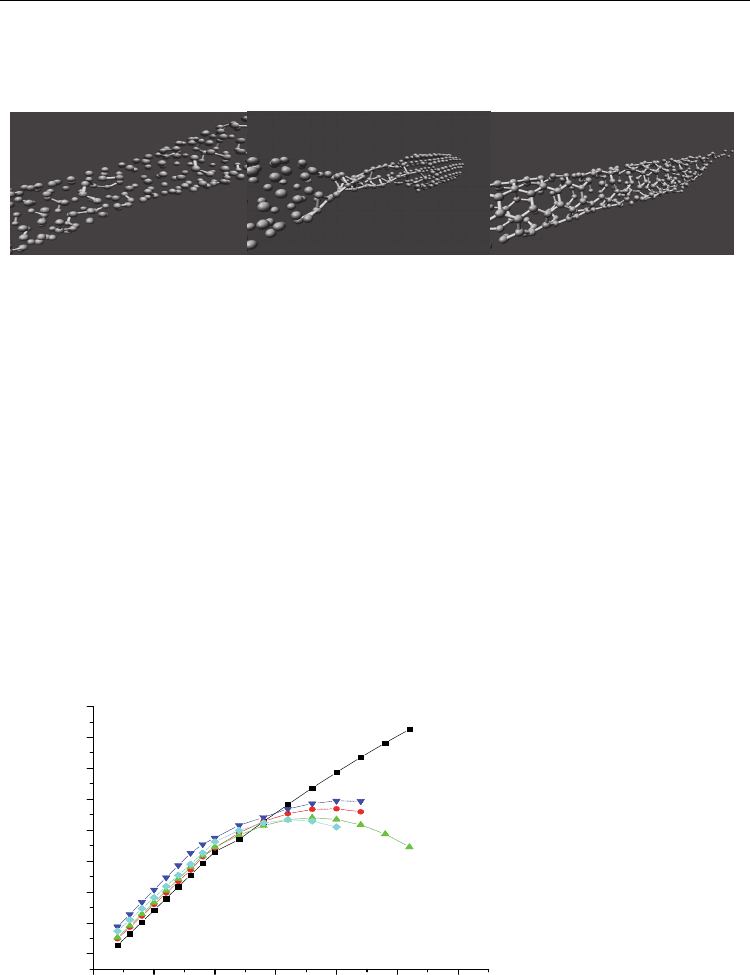
Carbon Nanotubes - Synthesis, Characterization, Applications
304
breaking [Fig 13(a)] is not so sharp. It includes maximum bond breaking with necking. Fig
13(b) shows the fracture of a chiral tube with 3 defects while Fig 13(c) is the same picture for
an armchair tube. As stated earlier, twisting of the tube in Fig 13(b) is prominent.
(a) (b) (c)
Fig. 13. Breaking of a (a) (10, 0) SWCNT with 3 defects at (0.00,3.91,90), (4.26,3.91,126), (3.91,
3.87, 171), (b) chiral SWCNT with 3 defects at (0.00,3.91,90), (-8.52,3.91,-90), (-17.04.3.89,90)
and (c) an armchair SWCNT with 3 defects at .(-5.53,3.37,-90),(0.61,3.37,90), (5.53,3.37,-90)
5.4.4 Results of inclusion of 4 defects at different positions
When four SW defects are introduced in the three different SWCNTs, an armchair tube is
found to be influenced greatly by it [Table 4]. Tensile strain of an armchair SWCNT is
dropped by 53%. The maximum strain of a chiral SWCNT [Table 3]is greatly influenced by
the inclusion of 4 defects while such change is not observed for a zigzag tube [Fig 14, Table
2]. Two pairs of diagonal defects reduce the ductility of a chiral tube by 46%. 16% failure
strain in this case is close to the experimental result of M. F. Yu (Yu et al, 2000c). Sharp
breakings are observed for a chiral [Fig 15(b)] and an armchair [Fig 15(c)]tubes where
breaking of a zigzag tube [Fig 15(a)] is not always so sharp.
0.00 0.05 0.10 0.15 0.20 0.25 0.30
0
20
40
60
80
100
120
140
160
4 overlapping defects
same distance & same line
different distances &
different orientations
different distances & same orientation
same distance & different orientations
STRESS IN GPa
STRAIN
Fig. 14. Stress-Strain curves of a (10, 0) SWNT with 4 defects at different positions
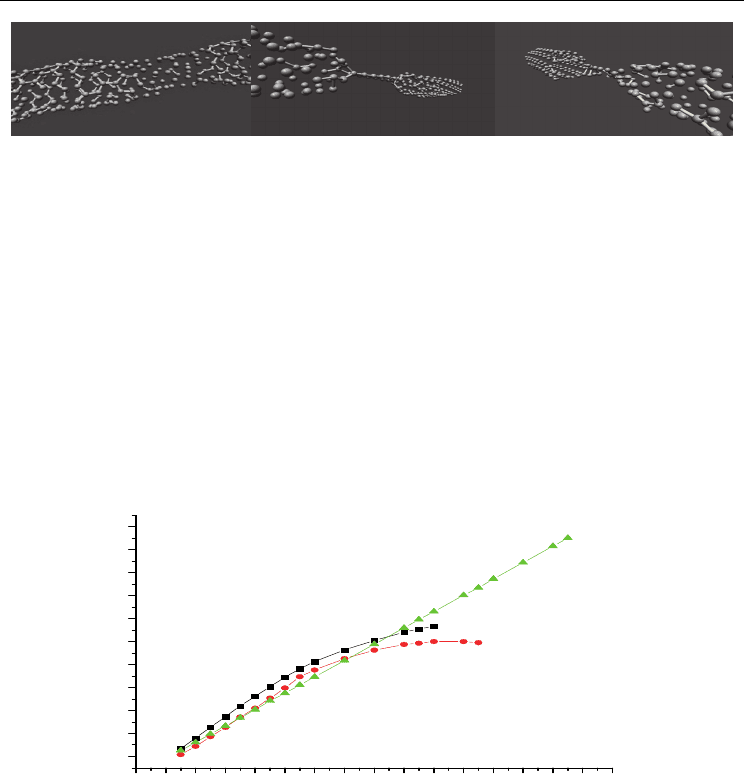
Molecular Dynamics Simulation Study on the Mechanical
Properties and Fracture Behavior of Single-Wall Carbon Nanotubes
305
(a) (b) (c)
Fig. 15. Breaking of (a) a (10,0) SWCNT with 4 defects at (z, r, θ) positions ( -4.26,3.91,90),
(12.78,3.91,90), ( 4.26,3.91,90), (-12.78,3.91,90) (b) (5,3) SWCNT with 4 defects at (-5.02,
2.73,97), (0.61, 2.65, 92), (3.04, 2.65, 99), (7.45, 2.70,90) (c) (5,5) SWCNT with 4 defects at (-
4.3,3.37,90), (-1.84,3.37,126), (5.53,3.37,90) and (6.76,3.37,126)
5.4.5 Comparison between the three tubes considering the same defects inside
The difference between the mechanical responses of the three types of SWCNTs is studied
and they are tabulated in Table 2, 3 and 4. When the three tubes are considered with the
same defective condition, large variations are observed. For example, Fig 16 and Fig 17 are
the stress strain curves of three tubes with 2 diagonal defects [Fig 16] and four symmetrical
defects on the same line [Fig 17] respectively. Nature of the curves is completely changed in
the two cases. That proves the symmetry dependent characteristics of single-wall carbon
nanotubes when their mechanical properties are concerned. From Table 1, a summary of the
results can be obtained.
-0 .020.0 00.0 20 .0 40.0 60 .0 80 .1 00 .1 20 .1 40 .160 .180 .200 .220 .240 .260 .280 .30
0
20
40
60
80
100
120
140
160
180
200
A rm c h a ir (5 ,5 ) S W C N T
C h ira l (5 ,3 ) S W C N T
Zigzag (10,0) SW CNT
STRESS IN GPa
STRAIN
Fig. 16. Comparison of the strain-strain curves of the three tubes for 2 diagonal defects
The above study reveals that the structure of a CNT has special effect on its mechanical
behavior. Zigzag symmetry has less influence on the ductility, where chiral and zigzag
symmetry affect the ductility greatly. So the ductility of a zigzag SWCNT is not influenced
by the presence of SW defects in its structure. A chiral tube shows less stability with
increasing number of defects. Neighboring defects, especially overlapping defects reduce
the strength of a zigzag and armchair tubes mostly but for chiral tube effect of overlapping
defects is not so pronounced. For a cylindrical geometry of a CNT, their mechanical
response is thus can be influenced by the position, arrangement and orientation of the
defects as well as by the symmetry of the tube. Table 1 gives the comparison in tabulated
form.

Carbon Nanotubes - Synthesis, Characterization, Applications
306
-0.020.00 0.02 0.04 0.06 0.08 0.10 0.12 0.14 0.16 0.18 0.20 0.22 0.24 0.26 0.28
0
20
40
60
80
100
120
140
160
A rm ch air (5, 5) tu be
C h iral (5 , 3) tu b e
Zigzag (10, 0) tube
STRESS IN GPa
STRAIN
Fig. 17. Comparison of the stress-strain curves of the three tubes for 4 symmetric defects on
the same line
SWCNT Maximum reduction of Maximum reduction of Maximum reduction of
Y value and (z, r, θ) failure stress ductility and
position and (z, r , θ) position (z, r , θ) position
Zigzag: 23% for 4 defects at 41.9% for 2 defects at No significant
(10, 0) (0.00,3.91,90),(4.26,3.91,90) (-1.06,3.87,-9), (1.06,3.87,27) reduction
(-4.26,3.91,90),(7.45,3.87,99)
Chiral: 10.4% for 3 defects at 42.9% for three defects at 46.7% for 4 defects at
(5, 3) (-21.15,2.73,94), (0.61,2.65,92), (-19.93,2.7,97), (0.46,2.73,24), (-6.24, 2.7, 94),(-2.59, 2.73,105)
(21.15,2.7,86) (19.93,2.73,83) (0.61, 2.65, 92), (3.8, 2.73, 79)
Armchair: 29.7% for 1 defect at 56.3% for three defects at 31.25% for 4 defects at
(5, 5) (-19.06, 3.37, 36) (-1.84,3.37,90),(0.61,3.37,90), (-4.3,3.37,90), (1.84,3.37,126)
(3.07,3.37,90) (5.53,3.37,90),(6.76,3.37,126)
Table 1. Maximum reduction of Young’s modulus, failure stress and ductility for the zigzag,
chiral and armchair SWCNTs and the corresponding (z, r, θ) values
Unlike the bulk materials, defects of various kinds are not always degrading the material
properties, but they may also be beneficial for fixing up the point of chemical
functionalization, charge injection and symmetry breaking effects and and also may
facilitate spectroscopic characterization process. Defect controlled future applications of
CNTs have now been paid attention and efforts are made to successfully create suitable
type and quantity of defects in their structure for specific purposes without compromising
their other excellent properties. Production of Y or T junction for producing electronic
devices or functionalization with different chemical groups at the defect sites to enhance
cohesion of the CNT fibers with the matrix element are some of the common uses of
defect sites.
The calculated result showing the interaction between SW defects however is still to be
proved experimentally. But the sites of SW defects are used for functionalisation of chemical
